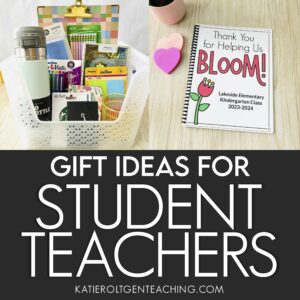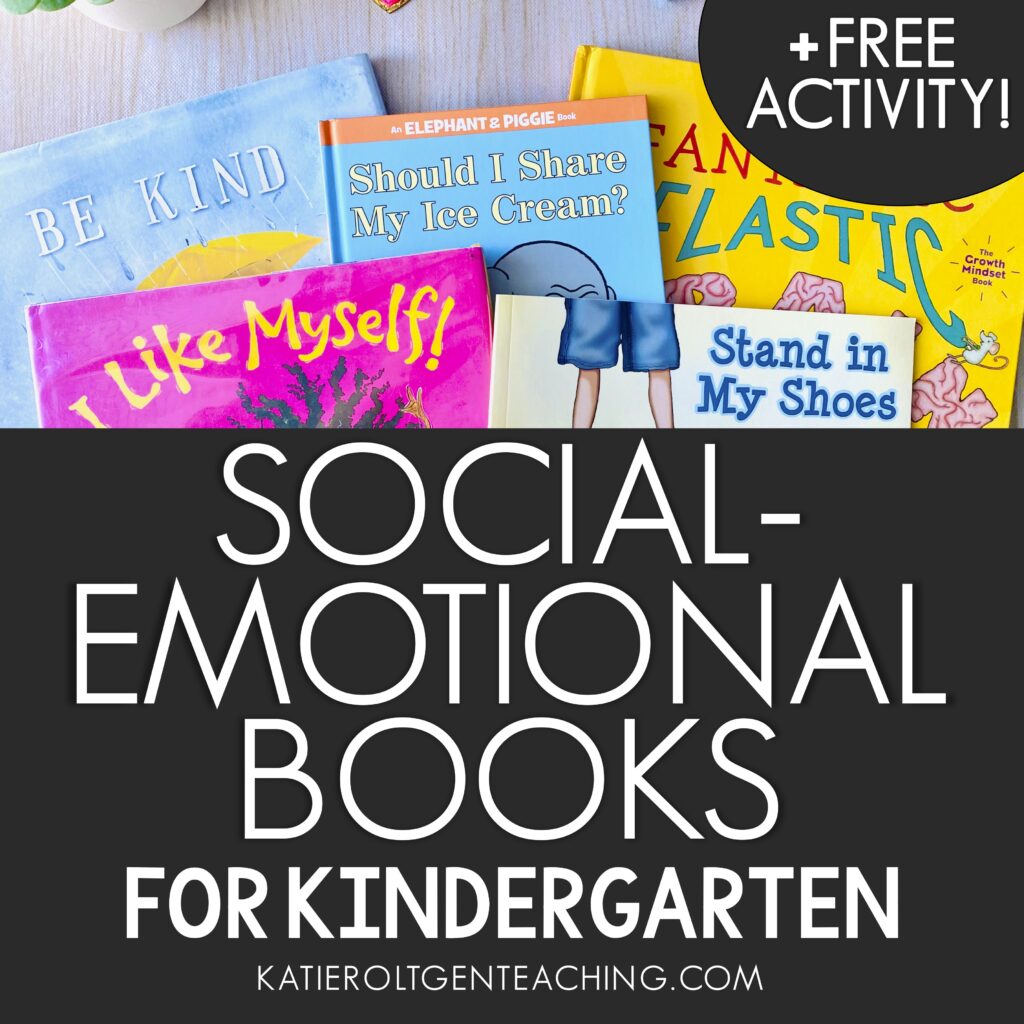
Menu
Social-emotional skills in 5 and 6-year-olds are like the first steps on a wobbly tightrope of emotions, a delicate dance between curiosity, excitement and occasional uncertainty. Using picture books becomes a magical compass, guiding our students through the landscape of big feelings.
When characters in stories feel like buddies, it’s like meeting familiar faces in a crowd, which in turn helps kids tackle tricky ideas like a breeze. Now, let’s dive into the fun part of social-emotional learning!
Let’s chat today about the best social emotional (SEL) books for kindergarten paired with fun activities to use with each of them (including a FREE kindness writing activity to incorporate into writing!)

Social emotional skills are actually one of the areas that schools look at to decide if a 5 year old is school ready. As much as we want kids to know their ABCs and be able to write their name legibly, sometimes having good SEL skills are actually ten times more important at this age because of the BIG emotions that this age group can have!
By kindergarten, teachers are looking for kids to have a better understanding of their emotional intelligence by showing self-awareness, self-regulation, empathy as well as the appropriate social skills such as greeting others, taking turns during play, etc.
There are many different options for teaching children about social emotional skills but I believe one of the best ways is through meaningful books. It is our job as educators to help kids learn how to identify their own feelings as well as teach them how to regulate their own emotions.
Who knew that the key to a kindergartener’s heart was tucked between the pages of a well-loved picture book?
Reading social-emotional books to kindergarteners isn’t just about loving stories—it’s like planting the seeds for being a feelings expert. These books are like little emotion adventures, teaching students not just to enjoy reading but also to get the lowdown on all the feels. It’s story time with a side of emotional smarts!
Let’s look at some of my favorite books for young readers to learn more about different social emotional skills! They are all broken up into different social emotional categories for you! At the end of each section, you will find two different engaging activities to try with students based on that category. Enjoy!
Relationship skills are the building blocks for a supportive classroom community, where kindergartners learn not only to express their emotions but also to connect with their peers, fostering an environment of trust, cooperation and lifelong friendships.
Making and keeping friends at a young age is such an important trait to understand. We must teach kids what makes someone a good friend but also how you yourself can be a good friend to others. It can be tricky to navigate but the following book list can help teach kids about the different aspects of friendship. Here are some of the best books to read to kids about friendship:
A great story about a special fish who learns the importance of sharing and being a good friend.
Gerald the Elephant wrestles with the decision of whether or not to share his ice cream.
Make Friendship Bracelets
Provide materials for students to create some simple friendship bracelets. Encourage them to exchange bracelets with a friend as a symbol of their friendship. You might even team up with the art teacher or make this a buddy project if you have a “buddy class” of upper elementary students.
The Friendship Circle Game
For this fun game, have students stand in a circle. Play music and have them pass a soft object around the circle (like a stuffed animal or stuffed ball). When the music stops, the student holding the object shares something they appreciate about the person next to them. Before playing this activity, make an anchor chart with some quick ideas for students to reference.
Explores various emotions, helping children identify and understand different feelings.
Jim Panzee wakes up feeling grumpy and learns that it’s okay to have feelings and ask for support from friends.
Feelings Faces Craft
Provide materials for students to create “feelings faces” by drawing different emotions on paper plates. Encourage them to share their faces and talk about when they might feel each emotion.
Empathy Skits
Divide the class into small groups and assign each group an emotion (happy, sad, surprised, etc.). Have them create short skits that express the assigned emotion, encouraging understanding and empathy.
Empowers children to handle everyday challenges and build problem-solving skills.
Encourages a growth mindset by showing that problems can be opportunities for learning and growth.
Problem-Solving Puzzles
Create simple puzzles or riddles related to common kindergarten challenges. Have students work in pairs or small groups to solve the problems and share their solutions with the class.
Make an Obstacle Course
Set up a small obstacle course and encourage students to navigate it together. Discuss the importance of teamwork and problem-solving as they figure out how to overcome obstacles.
Celebrates self-acceptance and self-confidence, encouraging children to embrace themselves just the way they are.
Follows a small blue engine who believes in himself and overcomes a big challenge.
Celebrates the experience of a young boy getting a fresh haircut and the confidence it brings.
Self-Portrait Collage
Provide magazines, scissors and glue for students to create self-portrait collages. Encourage them to include things that make them unique and special. You could do this after reading one of the books above or as a stand-alone activity.
Confidence Catwalk
Turn a corner of the classroom into a “catwalk” on Friday afternoons. Have students take turns walking down the catwalk holding their favorite piece of work from the week while their classmates cheer them on. This promotes self-confidence and positive reinforcement! (Plus its just a nice way to end the week on a high note!)
Explains the concept of a growth mindset and how the brain can grow and develop with effort and practice.
Follows a girl who perseveres through challenges to create something magnificent.
Create an “I Can” Wall
Create a bulletin board labeled “I Can” where students can display things they’ve accomplished or learned. This reinforces a growth mindset and celebrates individual achievements.
Growth Mindset Chants
Teach the class simple chants or cheers that emphasize the importance of effort and persistence. Practice these chants during transition times or before challenging activities.
Teaches children about personal space and respecting the space of others in a humorous way.
Helps children understand appropriate ways to use their hands and reinforces the importance of kindness.
Hula Hoop Challenge
Place hula hoops on the floor and have students stand inside them (you can borrow from P.E so you have enough). Explain that this is their “personal space.” Play music and have them dance inside their hoops, reinforcing the concept of personal space.
Move and Freeze
Play a game of “Move and Freeze.” When the music plays, students can move around the room, but when it stops, they must freeze in their personal space.
A class works together to create a “kindness quilt” by doing kind deeds for each other.
This book Follows CJ and his grandmother as they ride the bus through the city, highlighting the beauty of kindness and gratitude in unexpected places.
“Be Kind” emphasizes the power of small acts of kindness and encourages children to spread kindness in their everyday lives.
I Am a Kind Kid Craftivity (FREE)
This craftivity is perfect for Martin Luther King Jr. Day, Valentine’s Day, or anytime you’re celebrating the importance of kindness with your students! The templates are hand-drawn by me and can either be copied and used that way, or traced onto construction paper. There are four options for the writing page so you can use the activity with a variety of ages.
Kindness Chain
Create a paper chain with each link representing an act of kindness. As students perform acts of kindness, add links to the chain, visually reinforcing the huge impact of their actions. Challenge them to make the chain a certain length to earn a class reward and work together on being kind!
When we use children’s books to help teach students how to be kind, have personal space, show empathy, have a growth mindset, deal with conflict-resolution and problem solving and encourage confidence, we can hopefully expect some student wins in the area of social emotional skills. Teaching students these skills through SEL read-alouds is a wonderful teaching tool to use with kindergarteners.
It’s the perfect way to show kids relatable characters and scenarios, allowing children to connect with the stories on a personal level. As they see characters navigate various social and emotional situations, kindergartners can begin to recognize and understand their own feelings and those of others.
Overall, picture books provide a safe and non-threatening way to explore complex emotions and social dynamics in a kindergarten classroom.